Analyzing Geneva Construction: Quality and Business Improvement
VerifiedAdded on 2023/06/03
|14
|4527
|433
Case Study
AI Summary
This report analyzes the Geneva Insurance Company case study, focusing on its struggles with Total Quality Management (TQM) and the subsequent implementation of a Six Sigma program. The company, founded in 1922, aimed to expand but faced challenges in maintaining quality and efficiency. The case study highlights the failures of TQM implementation and explores the potential of Six Sigma to achieve operational excellence by addressing risks related to regulations, operations, and finances. The analysis examines the organizational, human, and technological errors that contributed to the TQM failures and the operational risks faced during the company's expansion. The report delves into risk management principles, the importance of identifying risks, and the key organizational activities requiring risk management. The findings emphasize the need for a comprehensive approach to risk management and operational excellence within the context of a construction and insurance company.
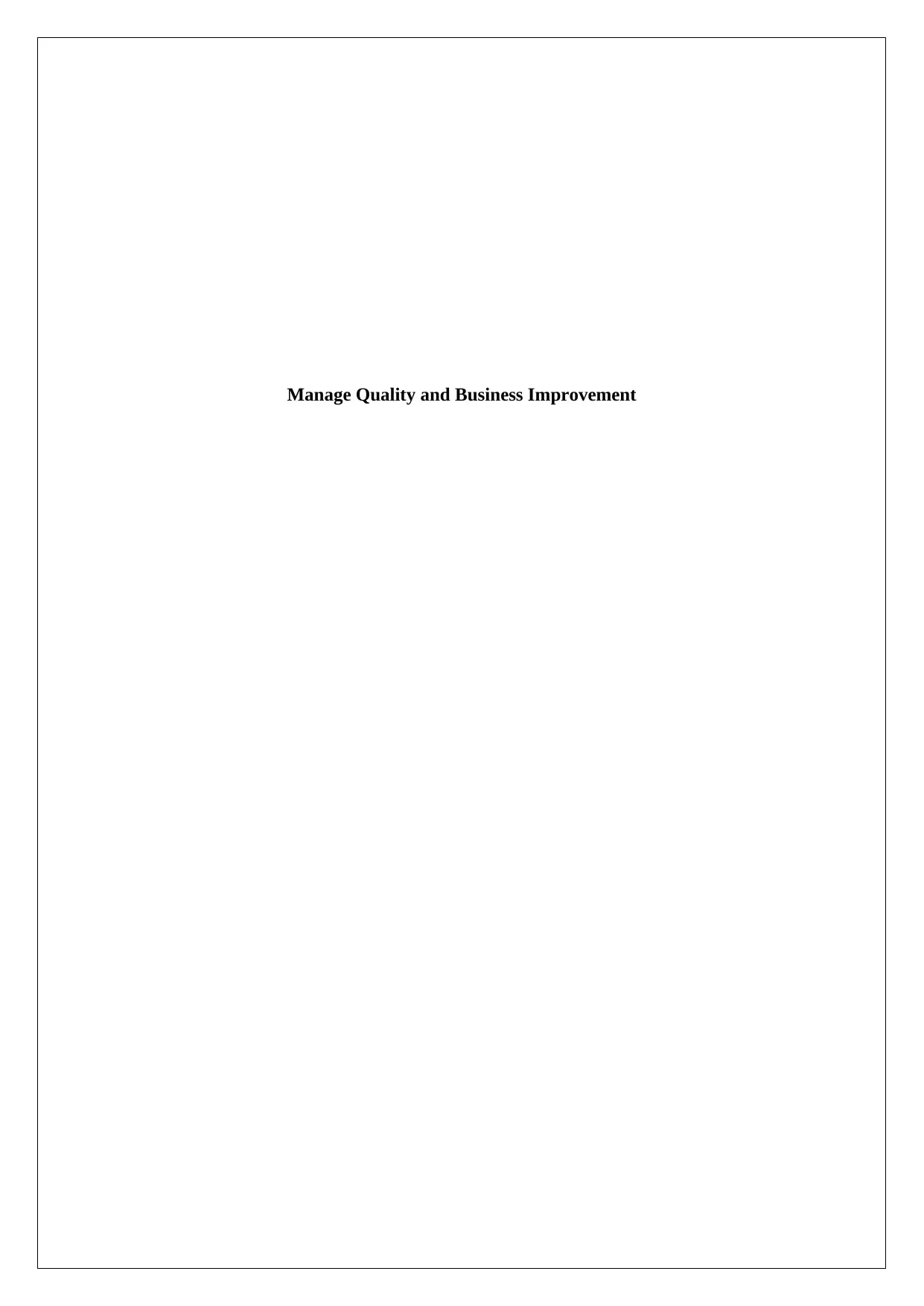
Manage Quality and Business Improvement
Paraphrase This Document
Need a fresh take? Get an instant paraphrase of this document with our AI Paraphraser
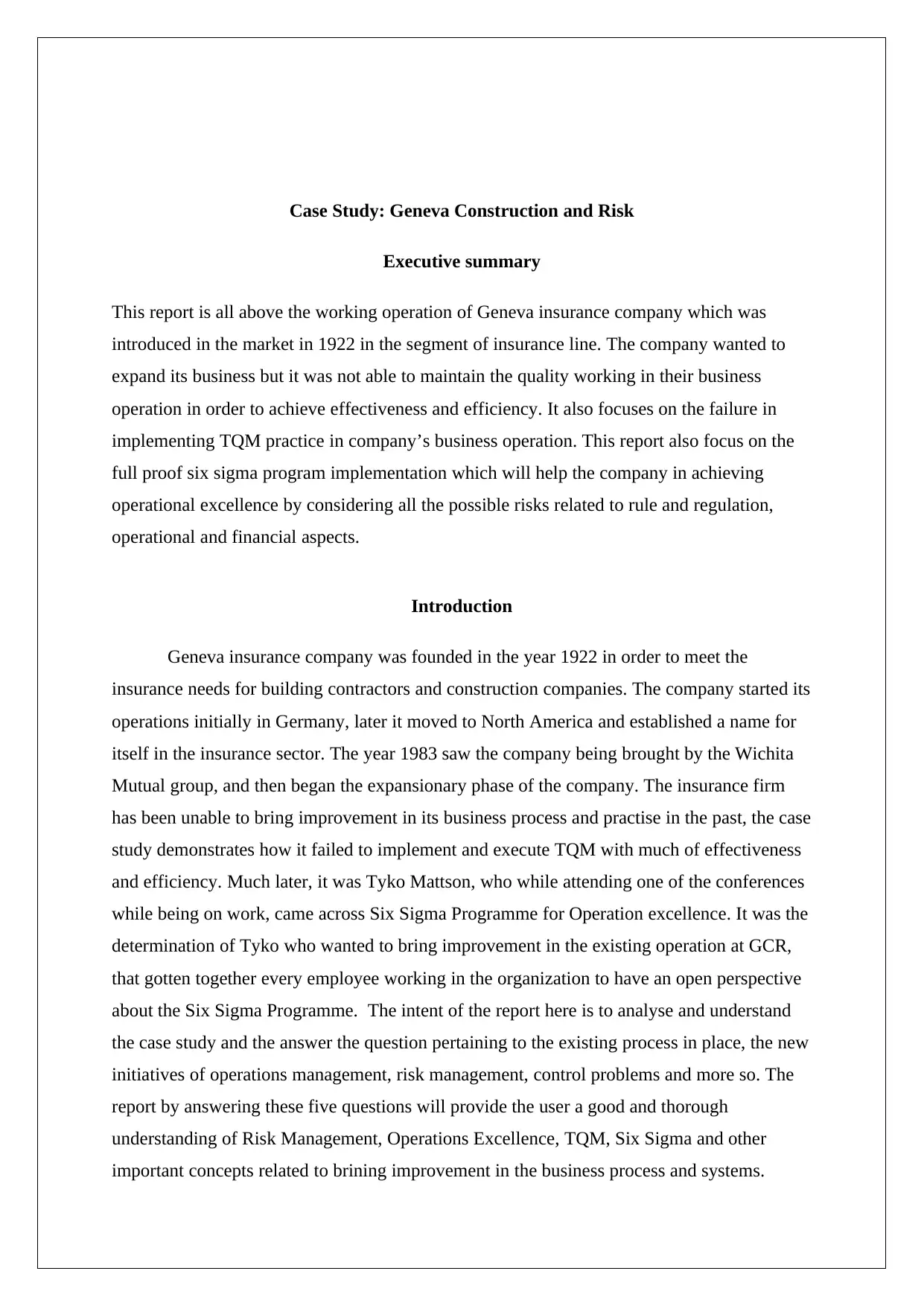
Case Study: Geneva Construction and Risk
Executive summary
This report is all above the working operation of Geneva insurance company which was
introduced in the market in 1922 in the segment of insurance line. The company wanted to
expand its business but it was not able to maintain the quality working in their business
operation in order to achieve effectiveness and efficiency. It also focuses on the failure in
implementing TQM practice in company’s business operation. This report also focus on the
full proof six sigma program implementation which will help the company in achieving
operational excellence by considering all the possible risks related to rule and regulation,
operational and financial aspects.
Introduction
Geneva insurance company was founded in the year 1922 in order to meet the
insurance needs for building contractors and construction companies. The company started its
operations initially in Germany, later it moved to North America and established a name for
itself in the insurance sector. The year 1983 saw the company being brought by the Wichita
Mutual group, and then began the expansionary phase of the company. The insurance firm
has been unable to bring improvement in its business process and practise in the past, the case
study demonstrates how it failed to implement and execute TQM with much of effectiveness
and efficiency. Much later, it was Tyko Mattson, who while attending one of the conferences
while being on work, came across Six Sigma Programme for Operation excellence. It was the
determination of Tyko who wanted to bring improvement in the existing operation at GCR,
that gotten together every employee working in the organization to have an open perspective
about the Six Sigma Programme. The intent of the report here is to analyse and understand
the case study and the answer the question pertaining to the existing process in place, the new
initiatives of operations management, risk management, control problems and more so. The
report by answering these five questions will provide the user a good and thorough
understanding of Risk Management, Operations Excellence, TQM, Six Sigma and other
important concepts related to brining improvement in the business process and systems.
Executive summary
This report is all above the working operation of Geneva insurance company which was
introduced in the market in 1922 in the segment of insurance line. The company wanted to
expand its business but it was not able to maintain the quality working in their business
operation in order to achieve effectiveness and efficiency. It also focuses on the failure in
implementing TQM practice in company’s business operation. This report also focus on the
full proof six sigma program implementation which will help the company in achieving
operational excellence by considering all the possible risks related to rule and regulation,
operational and financial aspects.
Introduction
Geneva insurance company was founded in the year 1922 in order to meet the
insurance needs for building contractors and construction companies. The company started its
operations initially in Germany, later it moved to North America and established a name for
itself in the insurance sector. The year 1983 saw the company being brought by the Wichita
Mutual group, and then began the expansionary phase of the company. The insurance firm
has been unable to bring improvement in its business process and practise in the past, the case
study demonstrates how it failed to implement and execute TQM with much of effectiveness
and efficiency. Much later, it was Tyko Mattson, who while attending one of the conferences
while being on work, came across Six Sigma Programme for Operation excellence. It was the
determination of Tyko who wanted to bring improvement in the existing operation at GCR,
that gotten together every employee working in the organization to have an open perspective
about the Six Sigma Programme. The intent of the report here is to analyse and understand
the case study and the answer the question pertaining to the existing process in place, the new
initiatives of operations management, risk management, control problems and more so. The
report by answering these five questions will provide the user a good and thorough
understanding of Risk Management, Operations Excellence, TQM, Six Sigma and other
important concepts related to brining improvement in the business process and systems.
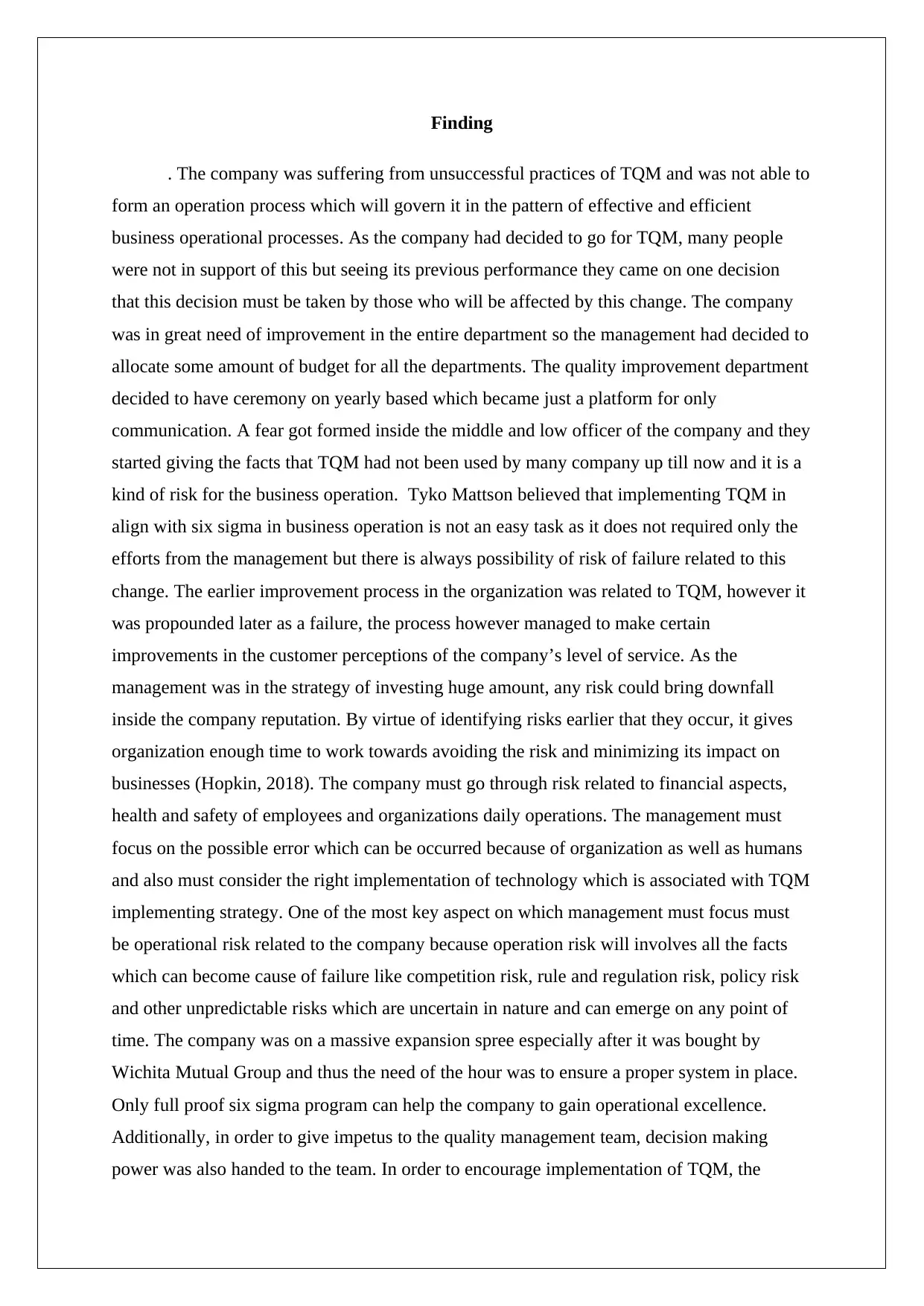
Finding
. The company was suffering from unsuccessful practices of TQM and was not able to
form an operation process which will govern it in the pattern of effective and efficient
business operational processes. As the company had decided to go for TQM, many people
were not in support of this but seeing its previous performance they came on one decision
that this decision must be taken by those who will be affected by this change. The company
was in great need of improvement in the entire department so the management had decided to
allocate some amount of budget for all the departments. The quality improvement department
decided to have ceremony on yearly based which became just a platform for only
communication. A fear got formed inside the middle and low officer of the company and they
started giving the facts that TQM had not been used by many company up till now and it is a
kind of risk for the business operation. Tyko Mattson believed that implementing TQM in
align with six sigma in business operation is not an easy task as it does not required only the
efforts from the management but there is always possibility of risk of failure related to this
change. The earlier improvement process in the organization was related to TQM, however it
was propounded later as a failure, the process however managed to make certain
improvements in the customer perceptions of the company’s level of service. As the
management was in the strategy of investing huge amount, any risk could bring downfall
inside the company reputation. By virtue of identifying risks earlier that they occur, it gives
organization enough time to work towards avoiding the risk and minimizing its impact on
businesses (Hopkin, 2018). The company must go through risk related to financial aspects,
health and safety of employees and organizations daily operations. The management must
focus on the possible error which can be occurred because of organization as well as humans
and also must consider the right implementation of technology which is associated with TQM
implementing strategy. One of the most key aspect on which management must focus must
be operational risk related to the company because operation risk will involves all the facts
which can become cause of failure like competition risk, rule and regulation risk, policy risk
and other unpredictable risks which are uncertain in nature and can emerge on any point of
time. The company was on a massive expansion spree especially after it was bought by
Wichita Mutual Group and thus the need of the hour was to ensure a proper system in place.
Only full proof six sigma program can help the company to gain operational excellence.
Additionally, in order to give impetus to the quality management team, decision making
power was also handed to the team. In order to encourage implementation of TQM, the
. The company was suffering from unsuccessful practices of TQM and was not able to
form an operation process which will govern it in the pattern of effective and efficient
business operational processes. As the company had decided to go for TQM, many people
were not in support of this but seeing its previous performance they came on one decision
that this decision must be taken by those who will be affected by this change. The company
was in great need of improvement in the entire department so the management had decided to
allocate some amount of budget for all the departments. The quality improvement department
decided to have ceremony on yearly based which became just a platform for only
communication. A fear got formed inside the middle and low officer of the company and they
started giving the facts that TQM had not been used by many company up till now and it is a
kind of risk for the business operation. Tyko Mattson believed that implementing TQM in
align with six sigma in business operation is not an easy task as it does not required only the
efforts from the management but there is always possibility of risk of failure related to this
change. The earlier improvement process in the organization was related to TQM, however it
was propounded later as a failure, the process however managed to make certain
improvements in the customer perceptions of the company’s level of service. As the
management was in the strategy of investing huge amount, any risk could bring downfall
inside the company reputation. By virtue of identifying risks earlier that they occur, it gives
organization enough time to work towards avoiding the risk and minimizing its impact on
businesses (Hopkin, 2018). The company must go through risk related to financial aspects,
health and safety of employees and organizations daily operations. The management must
focus on the possible error which can be occurred because of organization as well as humans
and also must consider the right implementation of technology which is associated with TQM
implementing strategy. One of the most key aspect on which management must focus must
be operational risk related to the company because operation risk will involves all the facts
which can become cause of failure like competition risk, rule and regulation risk, policy risk
and other unpredictable risks which are uncertain in nature and can emerge on any point of
time. The company was on a massive expansion spree especially after it was bought by
Wichita Mutual Group and thus the need of the hour was to ensure a proper system in place.
Only full proof six sigma program can help the company to gain operational excellence.
Additionally, in order to give impetus to the quality management team, decision making
power was also handed to the team. In order to encourage implementation of TQM, the
⊘ This is a preview!⊘
Do you want full access?
Subscribe today to unlock all pages.

Trusted by 1+ million students worldwide
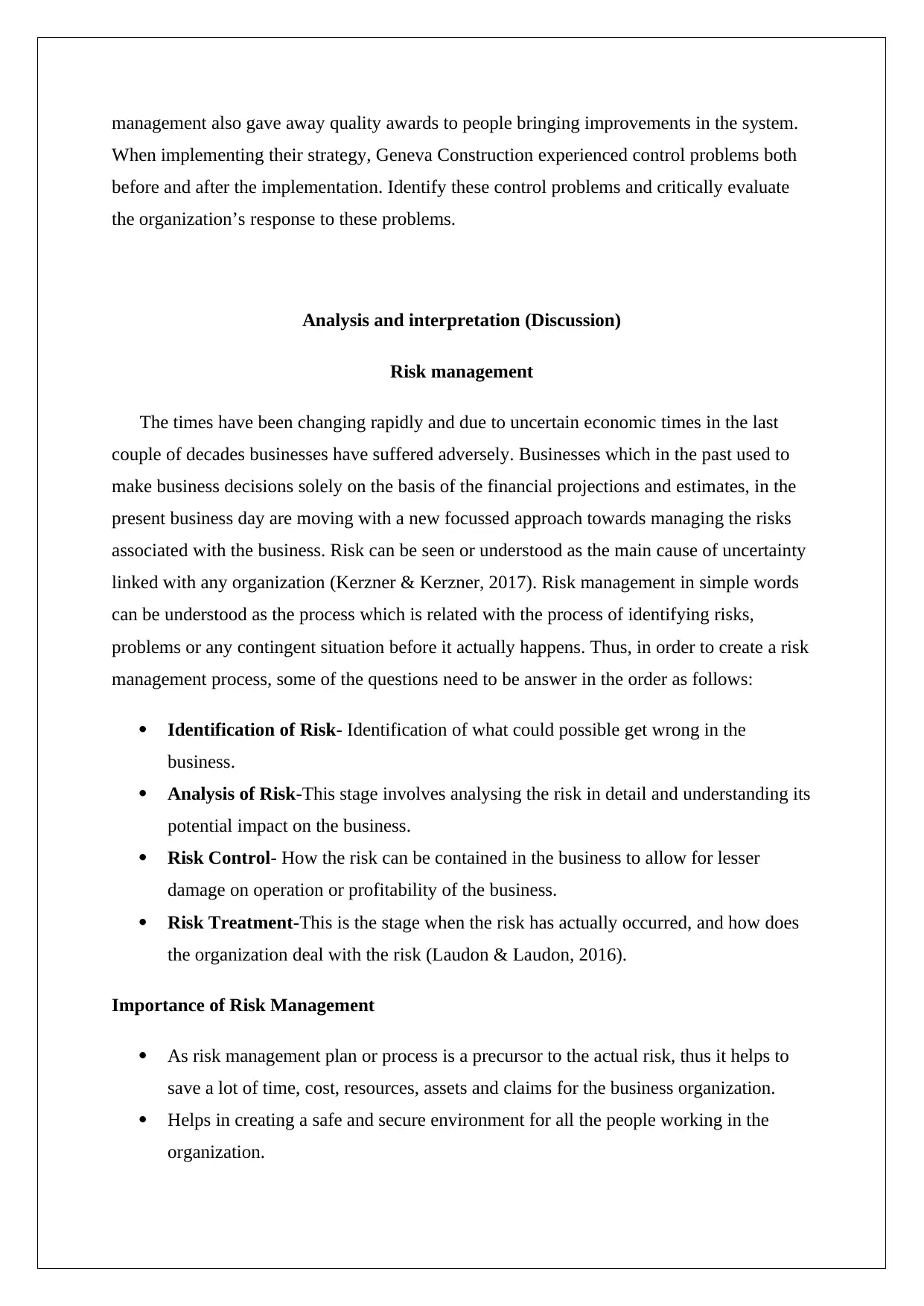
management also gave away quality awards to people bringing improvements in the system.
When implementing their strategy, Geneva Construction experienced control problems both
before and after the implementation. Identify these control problems and critically evaluate
the organization’s response to these problems.
Analysis and interpretation (Discussion)
Risk management
The times have been changing rapidly and due to uncertain economic times in the last
couple of decades businesses have suffered adversely. Businesses which in the past used to
make business decisions solely on the basis of the financial projections and estimates, in the
present business day are moving with a new focussed approach towards managing the risks
associated with the business. Risk can be seen or understood as the main cause of uncertainty
linked with any organization (Kerzner & Kerzner, 2017). Risk management in simple words
can be understood as the process which is related with the process of identifying risks,
problems or any contingent situation before it actually happens. Thus, in order to create a risk
management process, some of the questions need to be answer in the order as follows:
Identification of Risk- Identification of what could possible get wrong in the
business.
Analysis of Risk-This stage involves analysing the risk in detail and understanding its
potential impact on the business.
Risk Control- How the risk can be contained in the business to allow for lesser
damage on operation or profitability of the business.
Risk Treatment-This is the stage when the risk has actually occurred, and how does
the organization deal with the risk (Laudon & Laudon, 2016).
Importance of Risk Management
As risk management plan or process is a precursor to the actual risk, thus it helps to
save a lot of time, cost, resources, assets and claims for the business organization.
Helps in creating a safe and secure environment for all the people working in the
organization.
When implementing their strategy, Geneva Construction experienced control problems both
before and after the implementation. Identify these control problems and critically evaluate
the organization’s response to these problems.
Analysis and interpretation (Discussion)
Risk management
The times have been changing rapidly and due to uncertain economic times in the last
couple of decades businesses have suffered adversely. Businesses which in the past used to
make business decisions solely on the basis of the financial projections and estimates, in the
present business day are moving with a new focussed approach towards managing the risks
associated with the business. Risk can be seen or understood as the main cause of uncertainty
linked with any organization (Kerzner & Kerzner, 2017). Risk management in simple words
can be understood as the process which is related with the process of identifying risks,
problems or any contingent situation before it actually happens. Thus, in order to create a risk
management process, some of the questions need to be answer in the order as follows:
Identification of Risk- Identification of what could possible get wrong in the
business.
Analysis of Risk-This stage involves analysing the risk in detail and understanding its
potential impact on the business.
Risk Control- How the risk can be contained in the business to allow for lesser
damage on operation or profitability of the business.
Risk Treatment-This is the stage when the risk has actually occurred, and how does
the organization deal with the risk (Laudon & Laudon, 2016).
Importance of Risk Management
As risk management plan or process is a precursor to the actual risk, thus it helps to
save a lot of time, cost, resources, assets and claims for the business organization.
Helps in creating a safe and secure environment for all the people working in the
organization.
Paraphrase This Document
Need a fresh take? Get an instant paraphrase of this document with our AI Paraphraser
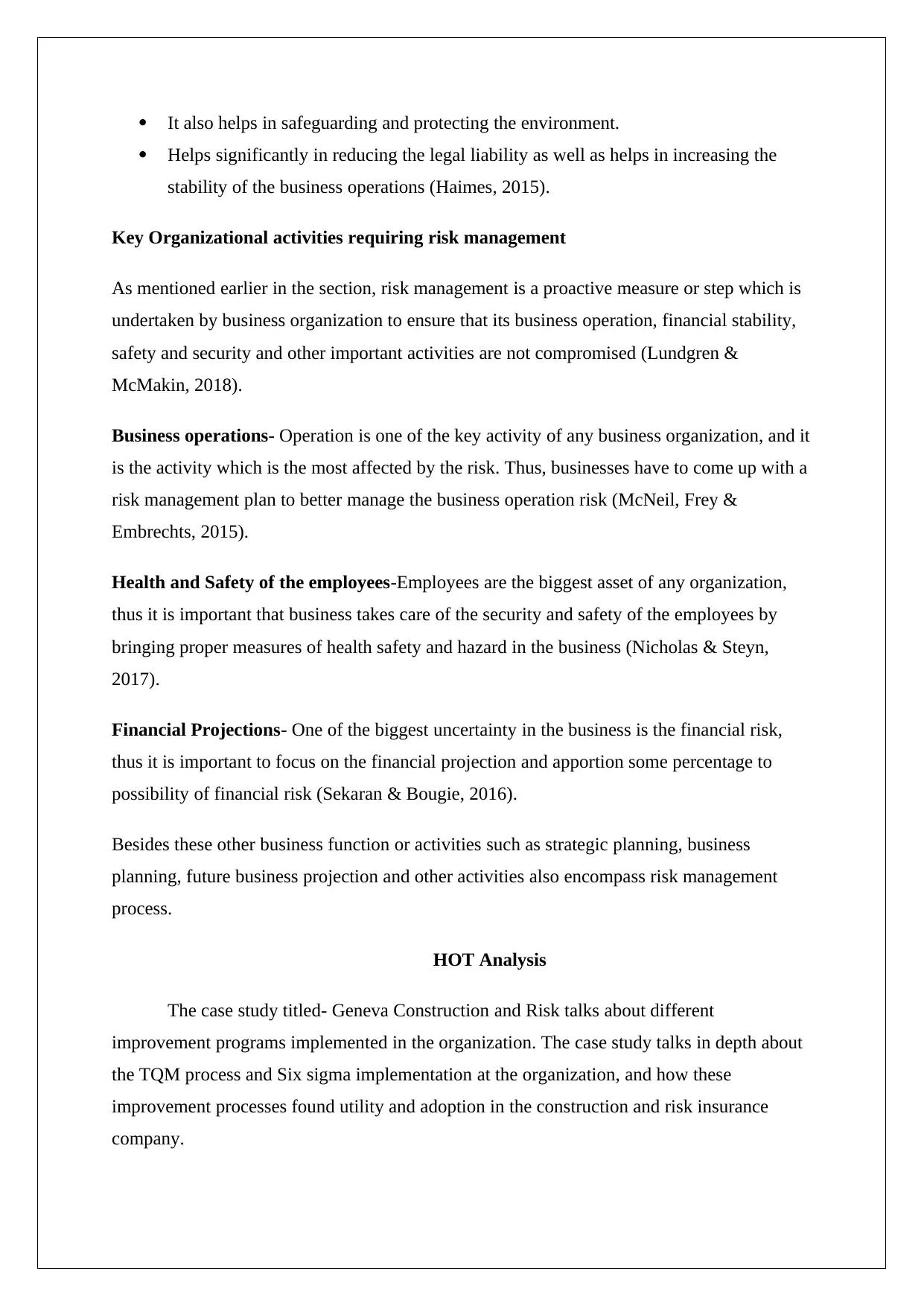
It also helps in safeguarding and protecting the environment.
Helps significantly in reducing the legal liability as well as helps in increasing the
stability of the business operations (Haimes, 2015).
Key Organizational activities requiring risk management
As mentioned earlier in the section, risk management is a proactive measure or step which is
undertaken by business organization to ensure that its business operation, financial stability,
safety and security and other important activities are not compromised (Lundgren &
McMakin, 2018).
Business operations- Operation is one of the key activity of any business organization, and it
is the activity which is the most affected by the risk. Thus, businesses have to come up with a
risk management plan to better manage the business operation risk (McNeil, Frey &
Embrechts, 2015).
Health and Safety of the employees-Employees are the biggest asset of any organization,
thus it is important that business takes care of the security and safety of the employees by
bringing proper measures of health safety and hazard in the business (Nicholas & Steyn,
2017).
Financial Projections- One of the biggest uncertainty in the business is the financial risk,
thus it is important to focus on the financial projection and apportion some percentage to
possibility of financial risk (Sekaran & Bougie, 2016).
Besides these other business function or activities such as strategic planning, business
planning, future business projection and other activities also encompass risk management
process.
HOT Analysis
The case study titled- Geneva Construction and Risk talks about different
improvement programs implemented in the organization. The case study talks in depth about
the TQM process and Six sigma implementation at the organization, and how these
improvement processes found utility and adoption in the construction and risk insurance
company.
Helps significantly in reducing the legal liability as well as helps in increasing the
stability of the business operations (Haimes, 2015).
Key Organizational activities requiring risk management
As mentioned earlier in the section, risk management is a proactive measure or step which is
undertaken by business organization to ensure that its business operation, financial stability,
safety and security and other important activities are not compromised (Lundgren &
McMakin, 2018).
Business operations- Operation is one of the key activity of any business organization, and it
is the activity which is the most affected by the risk. Thus, businesses have to come up with a
risk management plan to better manage the business operation risk (McNeil, Frey &
Embrechts, 2015).
Health and Safety of the employees-Employees are the biggest asset of any organization,
thus it is important that business takes care of the security and safety of the employees by
bringing proper measures of health safety and hazard in the business (Nicholas & Steyn,
2017).
Financial Projections- One of the biggest uncertainty in the business is the financial risk,
thus it is important to focus on the financial projection and apportion some percentage to
possibility of financial risk (Sekaran & Bougie, 2016).
Besides these other business function or activities such as strategic planning, business
planning, future business projection and other activities also encompass risk management
process.
HOT Analysis
The case study titled- Geneva Construction and Risk talks about different
improvement programs implemented in the organization. The case study talks in depth about
the TQM process and Six sigma implementation at the organization, and how these
improvement processes found utility and adoption in the construction and risk insurance
company.
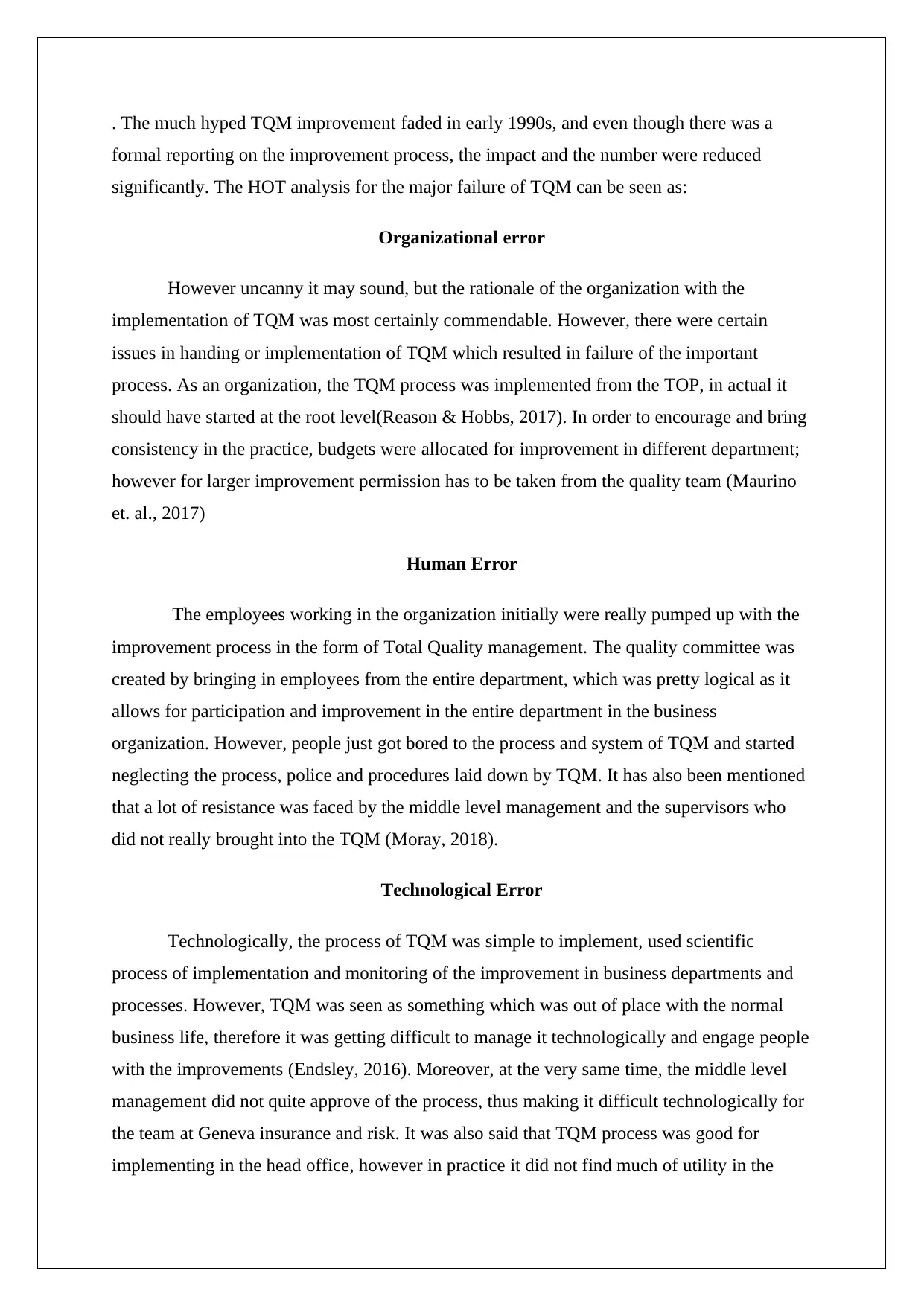
. The much hyped TQM improvement faded in early 1990s, and even though there was a
formal reporting on the improvement process, the impact and the number were reduced
significantly. The HOT analysis for the major failure of TQM can be seen as:
Organizational error
However uncanny it may sound, but the rationale of the organization with the
implementation of TQM was most certainly commendable. However, there were certain
issues in handing or implementation of TQM which resulted in failure of the important
process. As an organization, the TQM process was implemented from the TOP, in actual it
should have started at the root level(Reason & Hobbs, 2017). In order to encourage and bring
consistency in the practice, budgets were allocated for improvement in different department;
however for larger improvement permission has to be taken from the quality team (Maurino
et. al., 2017)
Human Error
The employees working in the organization initially were really pumped up with the
improvement process in the form of Total Quality management. The quality committee was
created by bringing in employees from the entire department, which was pretty logical as it
allows for participation and improvement in the entire department in the business
organization. However, people just got bored to the process and system of TQM and started
neglecting the process, police and procedures laid down by TQM. It has also been mentioned
that a lot of resistance was faced by the middle level management and the supervisors who
did not really brought into the TQM (Moray, 2018).
Technological Error
Technologically, the process of TQM was simple to implement, used scientific
process of implementation and monitoring of the improvement in business departments and
processes. However, TQM was seen as something which was out of place with the normal
business life, therefore it was getting difficult to manage it technologically and engage people
with the improvements (Endsley, 2016). Moreover, at the very same time, the middle level
management did not quite approve of the process, thus making it difficult technologically for
the team at Geneva insurance and risk. It was also said that TQM process was good for
implementing in the head office, however in practice it did not find much of utility in the
formal reporting on the improvement process, the impact and the number were reduced
significantly. The HOT analysis for the major failure of TQM can be seen as:
Organizational error
However uncanny it may sound, but the rationale of the organization with the
implementation of TQM was most certainly commendable. However, there were certain
issues in handing or implementation of TQM which resulted in failure of the important
process. As an organization, the TQM process was implemented from the TOP, in actual it
should have started at the root level(Reason & Hobbs, 2017). In order to encourage and bring
consistency in the practice, budgets were allocated for improvement in different department;
however for larger improvement permission has to be taken from the quality team (Maurino
et. al., 2017)
Human Error
The employees working in the organization initially were really pumped up with the
improvement process in the form of Total Quality management. The quality committee was
created by bringing in employees from the entire department, which was pretty logical as it
allows for participation and improvement in the entire department in the business
organization. However, people just got bored to the process and system of TQM and started
neglecting the process, police and procedures laid down by TQM. It has also been mentioned
that a lot of resistance was faced by the middle level management and the supervisors who
did not really brought into the TQM (Moray, 2018).
Technological Error
Technologically, the process of TQM was simple to implement, used scientific
process of implementation and monitoring of the improvement in business departments and
processes. However, TQM was seen as something which was out of place with the normal
business life, therefore it was getting difficult to manage it technologically and engage people
with the improvements (Endsley, 2016). Moreover, at the very same time, the middle level
management did not quite approve of the process, thus making it difficult technologically for
the team at Geneva insurance and risk. It was also said that TQM process was good for
implementing in the head office, however in practice it did not find much of utility in the
⊘ This is a preview!⊘
Do you want full access?
Subscribe today to unlock all pages.

Trusted by 1+ million students worldwide
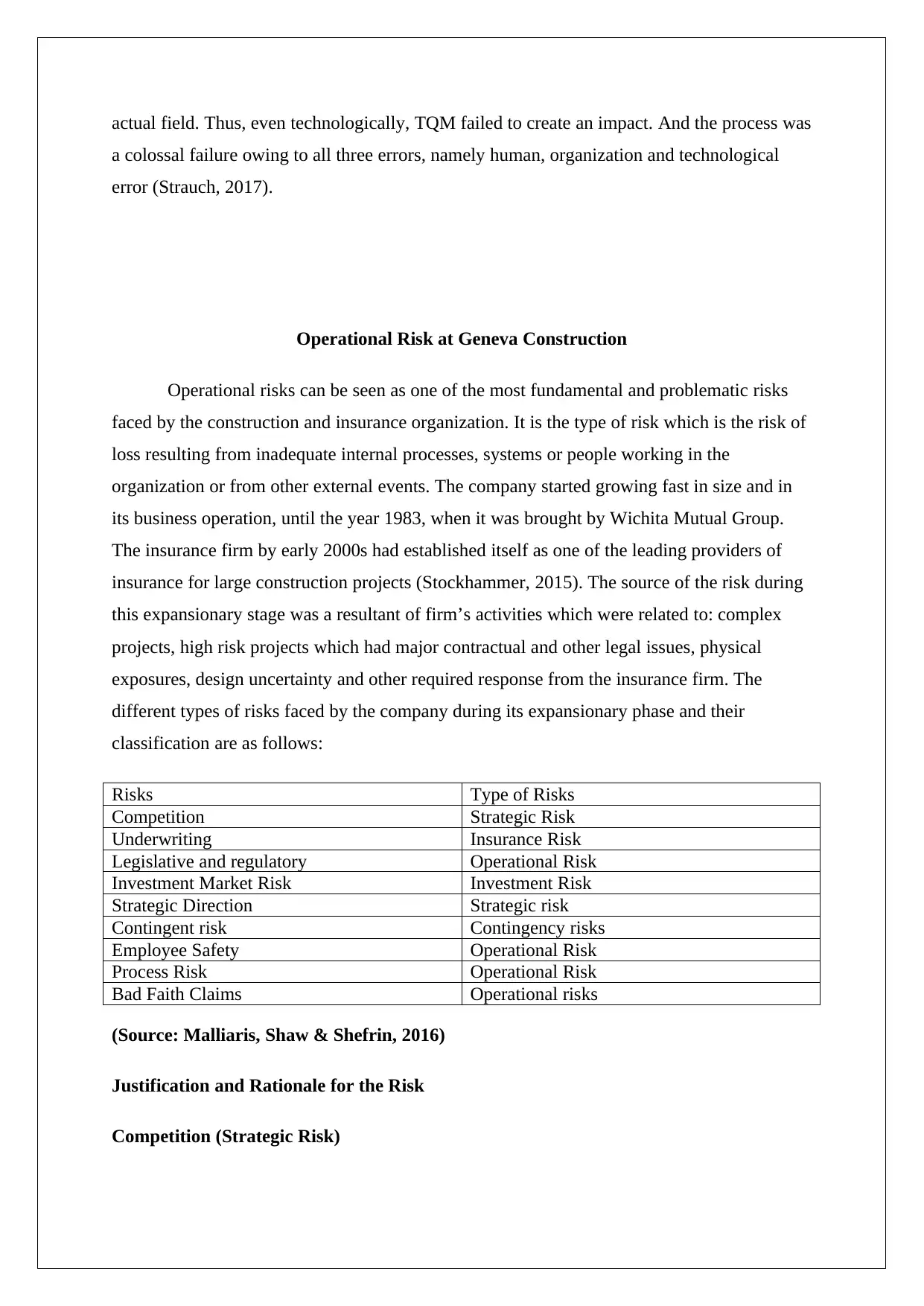
actual field. Thus, even technologically, TQM failed to create an impact. And the process was
a colossal failure owing to all three errors, namely human, organization and technological
error (Strauch, 2017).
Operational Risk at Geneva Construction
Operational risks can be seen as one of the most fundamental and problematic risks
faced by the construction and insurance organization. It is the type of risk which is the risk of
loss resulting from inadequate internal processes, systems or people working in the
organization or from other external events. The company started growing fast in size and in
its business operation, until the year 1983, when it was brought by Wichita Mutual Group.
The insurance firm by early 2000s had established itself as one of the leading providers of
insurance for large construction projects (Stockhammer, 2015). The source of the risk during
this expansionary stage was a resultant of firm’s activities which were related to: complex
projects, high risk projects which had major contractual and other legal issues, physical
exposures, design uncertainty and other required response from the insurance firm. The
different types of risks faced by the company during its expansionary phase and their
classification are as follows:
Risks Type of Risks
Competition Strategic Risk
Underwriting Insurance Risk
Legislative and regulatory Operational Risk
Investment Market Risk Investment Risk
Strategic Direction Strategic risk
Contingent risk Contingency risks
Employee Safety Operational Risk
Process Risk Operational Risk
Bad Faith Claims Operational risks
(Source: Malliaris, Shaw & Shefrin, 2016)
Justification and Rationale for the Risk
Competition (Strategic Risk)
a colossal failure owing to all three errors, namely human, organization and technological
error (Strauch, 2017).
Operational Risk at Geneva Construction
Operational risks can be seen as one of the most fundamental and problematic risks
faced by the construction and insurance organization. It is the type of risk which is the risk of
loss resulting from inadequate internal processes, systems or people working in the
organization or from other external events. The company started growing fast in size and in
its business operation, until the year 1983, when it was brought by Wichita Mutual Group.
The insurance firm by early 2000s had established itself as one of the leading providers of
insurance for large construction projects (Stockhammer, 2015). The source of the risk during
this expansionary stage was a resultant of firm’s activities which were related to: complex
projects, high risk projects which had major contractual and other legal issues, physical
exposures, design uncertainty and other required response from the insurance firm. The
different types of risks faced by the company during its expansionary phase and their
classification are as follows:
Risks Type of Risks
Competition Strategic Risk
Underwriting Insurance Risk
Legislative and regulatory Operational Risk
Investment Market Risk Investment Risk
Strategic Direction Strategic risk
Contingent risk Contingency risks
Employee Safety Operational Risk
Process Risk Operational Risk
Bad Faith Claims Operational risks
(Source: Malliaris, Shaw & Shefrin, 2016)
Justification and Rationale for the Risk
Competition (Strategic Risk)
Paraphrase This Document
Need a fresh take? Get an instant paraphrase of this document with our AI Paraphraser
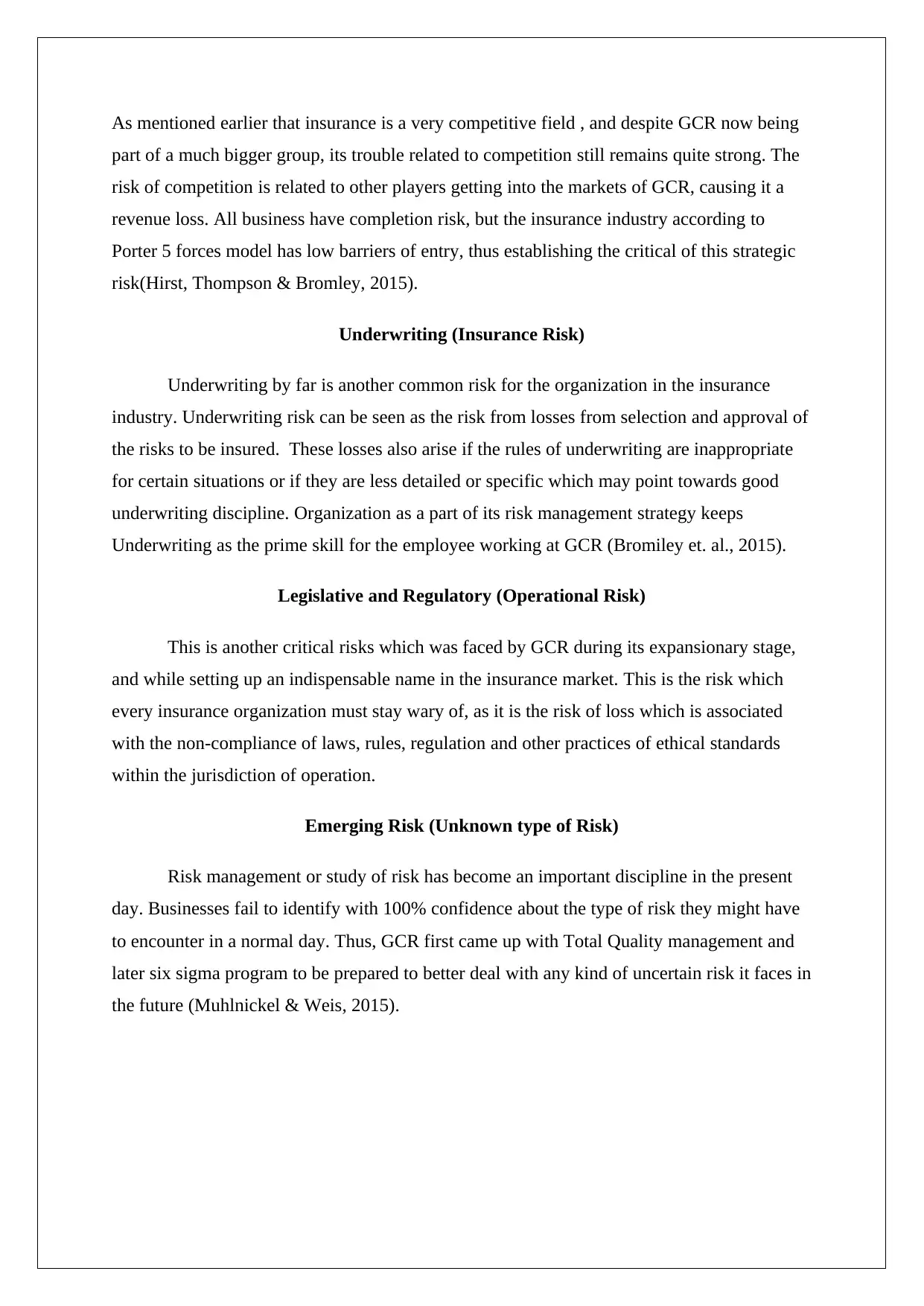
As mentioned earlier that insurance is a very competitive field , and despite GCR now being
part of a much bigger group, its trouble related to competition still remains quite strong. The
risk of competition is related to other players getting into the markets of GCR, causing it a
revenue loss. All business have completion risk, but the insurance industry according to
Porter 5 forces model has low barriers of entry, thus establishing the critical of this strategic
risk(Hirst, Thompson & Bromley, 2015).
Underwriting (Insurance Risk)
Underwriting by far is another common risk for the organization in the insurance
industry. Underwriting risk can be seen as the risk from losses from selection and approval of
the risks to be insured. These losses also arise if the rules of underwriting are inappropriate
for certain situations or if they are less detailed or specific which may point towards good
underwriting discipline. Organization as a part of its risk management strategy keeps
Underwriting as the prime skill for the employee working at GCR (Bromiley et. al., 2015).
Legislative and Regulatory (Operational Risk)
This is another critical risks which was faced by GCR during its expansionary stage,
and while setting up an indispensable name in the insurance market. This is the risk which
every insurance organization must stay wary of, as it is the risk of loss which is associated
with the non-compliance of laws, rules, regulation and other practices of ethical standards
within the jurisdiction of operation.
Emerging Risk (Unknown type of Risk)
Risk management or study of risk has become an important discipline in the present
day. Businesses fail to identify with 100% confidence about the type of risk they might have
to encounter in a normal day. Thus, GCR first came up with Total Quality management and
later six sigma program to be prepared to better deal with any kind of uncertain risk it faces in
the future (Muhlnickel & Weis, 2015).
part of a much bigger group, its trouble related to competition still remains quite strong. The
risk of competition is related to other players getting into the markets of GCR, causing it a
revenue loss. All business have completion risk, but the insurance industry according to
Porter 5 forces model has low barriers of entry, thus establishing the critical of this strategic
risk(Hirst, Thompson & Bromley, 2015).
Underwriting (Insurance Risk)
Underwriting by far is another common risk for the organization in the insurance
industry. Underwriting risk can be seen as the risk from losses from selection and approval of
the risks to be insured. These losses also arise if the rules of underwriting are inappropriate
for certain situations or if they are less detailed or specific which may point towards good
underwriting discipline. Organization as a part of its risk management strategy keeps
Underwriting as the prime skill for the employee working at GCR (Bromiley et. al., 2015).
Legislative and Regulatory (Operational Risk)
This is another critical risks which was faced by GCR during its expansionary stage,
and while setting up an indispensable name in the insurance market. This is the risk which
every insurance organization must stay wary of, as it is the risk of loss which is associated
with the non-compliance of laws, rules, regulation and other practices of ethical standards
within the jurisdiction of operation.
Emerging Risk (Unknown type of Risk)
Risk management or study of risk has become an important discipline in the present
day. Businesses fail to identify with 100% confidence about the type of risk they might have
to encounter in a normal day. Thus, GCR first came up with Total Quality management and
later six sigma program to be prepared to better deal with any kind of uncertain risk it faces in
the future (Muhlnickel & Weis, 2015).
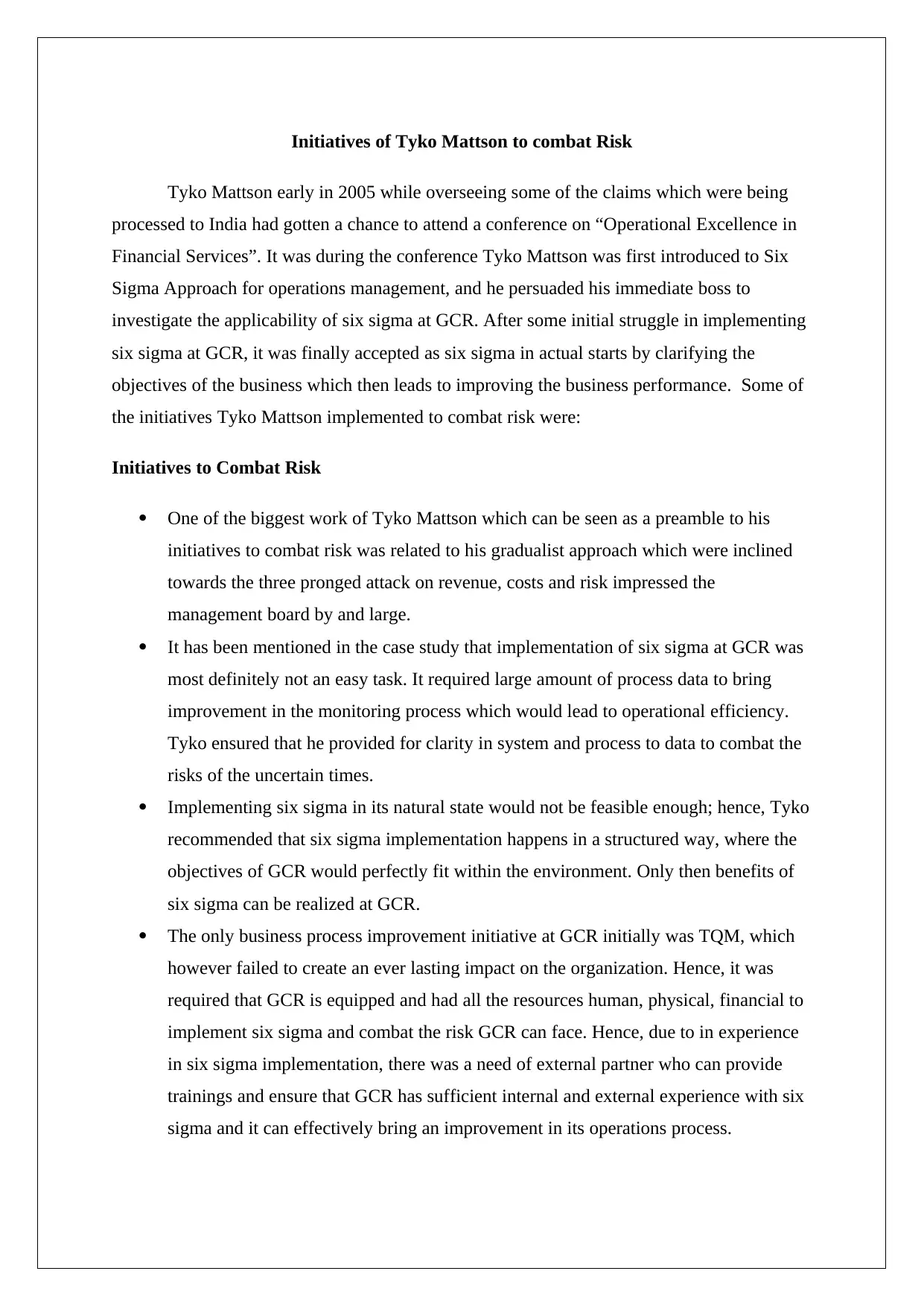
Initiatives of Tyko Mattson to combat Risk
Tyko Mattson early in 2005 while overseeing some of the claims which were being
processed to India had gotten a chance to attend a conference on “Operational Excellence in
Financial Services”. It was during the conference Tyko Mattson was first introduced to Six
Sigma Approach for operations management, and he persuaded his immediate boss to
investigate the applicability of six sigma at GCR. After some initial struggle in implementing
six sigma at GCR, it was finally accepted as six sigma in actual starts by clarifying the
objectives of the business which then leads to improving the business performance. Some of
the initiatives Tyko Mattson implemented to combat risk were:
Initiatives to Combat Risk
One of the biggest work of Tyko Mattson which can be seen as a preamble to his
initiatives to combat risk was related to his gradualist approach which were inclined
towards the three pronged attack on revenue, costs and risk impressed the
management board by and large.
It has been mentioned in the case study that implementation of six sigma at GCR was
most definitely not an easy task. It required large amount of process data to bring
improvement in the monitoring process which would lead to operational efficiency.
Tyko ensured that he provided for clarity in system and process to data to combat the
risks of the uncertain times.
Implementing six sigma in its natural state would not be feasible enough; hence, Tyko
recommended that six sigma implementation happens in a structured way, where the
objectives of GCR would perfectly fit within the environment. Only then benefits of
six sigma can be realized at GCR.
The only business process improvement initiative at GCR initially was TQM, which
however failed to create an ever lasting impact on the organization. Hence, it was
required that GCR is equipped and had all the resources human, physical, financial to
implement six sigma and combat the risk GCR can face. Hence, due to in experience
in six sigma implementation, there was a need of external partner who can provide
trainings and ensure that GCR has sufficient internal and external experience with six
sigma and it can effectively bring an improvement in its operations process.
Tyko Mattson early in 2005 while overseeing some of the claims which were being
processed to India had gotten a chance to attend a conference on “Operational Excellence in
Financial Services”. It was during the conference Tyko Mattson was first introduced to Six
Sigma Approach for operations management, and he persuaded his immediate boss to
investigate the applicability of six sigma at GCR. After some initial struggle in implementing
six sigma at GCR, it was finally accepted as six sigma in actual starts by clarifying the
objectives of the business which then leads to improving the business performance. Some of
the initiatives Tyko Mattson implemented to combat risk were:
Initiatives to Combat Risk
One of the biggest work of Tyko Mattson which can be seen as a preamble to his
initiatives to combat risk was related to his gradualist approach which were inclined
towards the three pronged attack on revenue, costs and risk impressed the
management board by and large.
It has been mentioned in the case study that implementation of six sigma at GCR was
most definitely not an easy task. It required large amount of process data to bring
improvement in the monitoring process which would lead to operational efficiency.
Tyko ensured that he provided for clarity in system and process to data to combat the
risks of the uncertain times.
Implementing six sigma in its natural state would not be feasible enough; hence, Tyko
recommended that six sigma implementation happens in a structured way, where the
objectives of GCR would perfectly fit within the environment. Only then benefits of
six sigma can be realized at GCR.
The only business process improvement initiative at GCR initially was TQM, which
however failed to create an ever lasting impact on the organization. Hence, it was
required that GCR is equipped and had all the resources human, physical, financial to
implement six sigma and combat the risk GCR can face. Hence, due to in experience
in six sigma implementation, there was a need of external partner who can provide
trainings and ensure that GCR has sufficient internal and external experience with six
sigma and it can effectively bring an improvement in its operations process.
⊘ This is a preview!⊘
Do you want full access?
Subscribe today to unlock all pages.

Trusted by 1+ million students worldwide
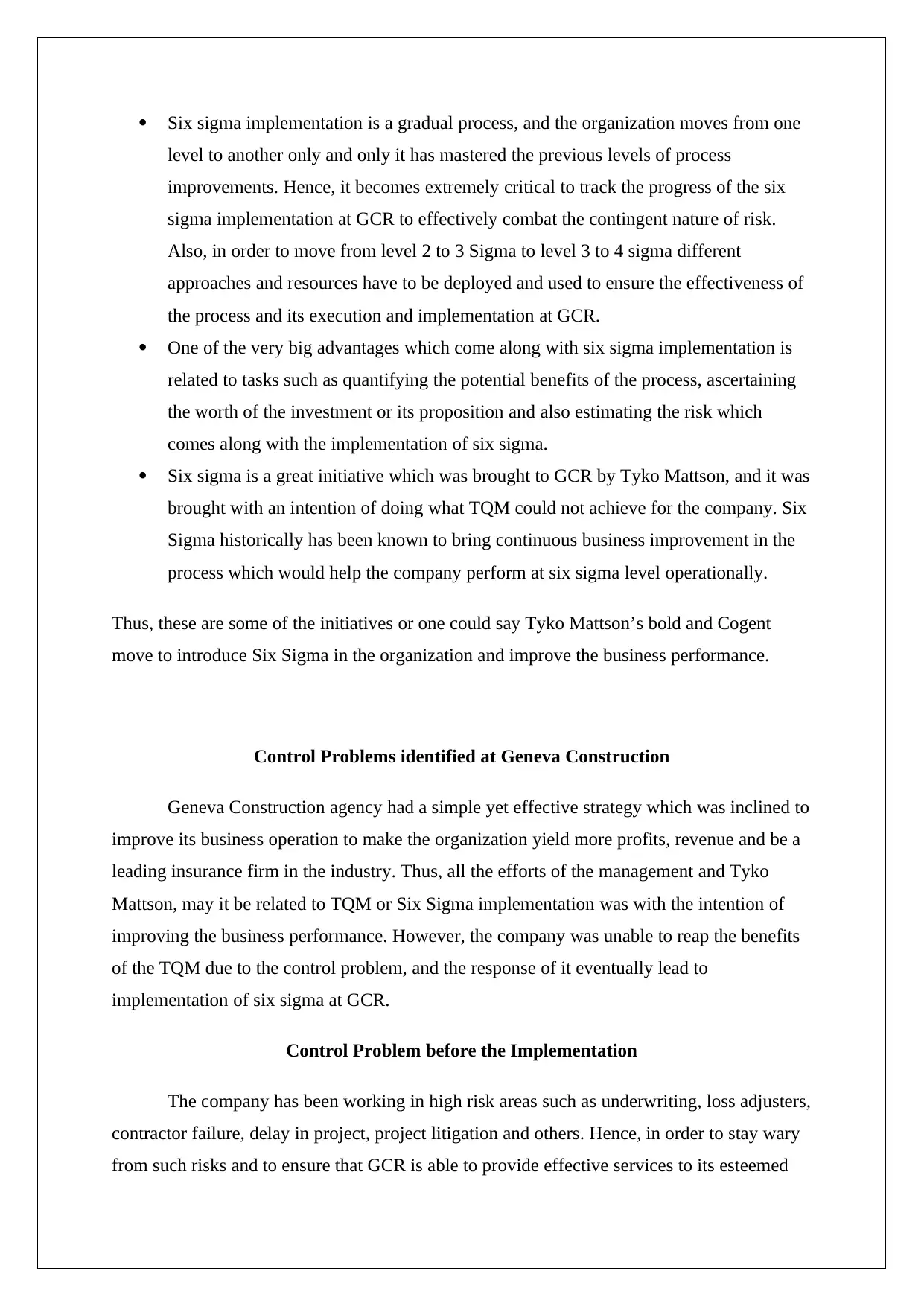
Six sigma implementation is a gradual process, and the organization moves from one
level to another only and only it has mastered the previous levels of process
improvements. Hence, it becomes extremely critical to track the progress of the six
sigma implementation at GCR to effectively combat the contingent nature of risk.
Also, in order to move from level 2 to 3 Sigma to level 3 to 4 sigma different
approaches and resources have to be deployed and used to ensure the effectiveness of
the process and its execution and implementation at GCR.
One of the very big advantages which come along with six sigma implementation is
related to tasks such as quantifying the potential benefits of the process, ascertaining
the worth of the investment or its proposition and also estimating the risk which
comes along with the implementation of six sigma.
Six sigma is a great initiative which was brought to GCR by Tyko Mattson, and it was
brought with an intention of doing what TQM could not achieve for the company. Six
Sigma historically has been known to bring continuous business improvement in the
process which would help the company perform at six sigma level operationally.
Thus, these are some of the initiatives or one could say Tyko Mattson’s bold and Cogent
move to introduce Six Sigma in the organization and improve the business performance.
Control Problems identified at Geneva Construction
Geneva Construction agency had a simple yet effective strategy which was inclined to
improve its business operation to make the organization yield more profits, revenue and be a
leading insurance firm in the industry. Thus, all the efforts of the management and Tyko
Mattson, may it be related to TQM or Six Sigma implementation was with the intention of
improving the business performance. However, the company was unable to reap the benefits
of the TQM due to the control problem, and the response of it eventually lead to
implementation of six sigma at GCR.
Control Problem before the Implementation
The company has been working in high risk areas such as underwriting, loss adjusters,
contractor failure, delay in project, project litigation and others. Hence, in order to stay wary
from such risks and to ensure that GCR is able to provide effective services to its esteemed
level to another only and only it has mastered the previous levels of process
improvements. Hence, it becomes extremely critical to track the progress of the six
sigma implementation at GCR to effectively combat the contingent nature of risk.
Also, in order to move from level 2 to 3 Sigma to level 3 to 4 sigma different
approaches and resources have to be deployed and used to ensure the effectiveness of
the process and its execution and implementation at GCR.
One of the very big advantages which come along with six sigma implementation is
related to tasks such as quantifying the potential benefits of the process, ascertaining
the worth of the investment or its proposition and also estimating the risk which
comes along with the implementation of six sigma.
Six sigma is a great initiative which was brought to GCR by Tyko Mattson, and it was
brought with an intention of doing what TQM could not achieve for the company. Six
Sigma historically has been known to bring continuous business improvement in the
process which would help the company perform at six sigma level operationally.
Thus, these are some of the initiatives or one could say Tyko Mattson’s bold and Cogent
move to introduce Six Sigma in the organization and improve the business performance.
Control Problems identified at Geneva Construction
Geneva Construction agency had a simple yet effective strategy which was inclined to
improve its business operation to make the organization yield more profits, revenue and be a
leading insurance firm in the industry. Thus, all the efforts of the management and Tyko
Mattson, may it be related to TQM or Six Sigma implementation was with the intention of
improving the business performance. However, the company was unable to reap the benefits
of the TQM due to the control problem, and the response of it eventually lead to
implementation of six sigma at GCR.
Control Problem before the Implementation
The company has been working in high risk areas such as underwriting, loss adjusters,
contractor failure, delay in project, project litigation and others. Hence, in order to stay wary
from such risks and to ensure that GCR is able to provide effective services to its esteemed
Paraphrase This Document
Need a fresh take? Get an instant paraphrase of this document with our AI Paraphraser
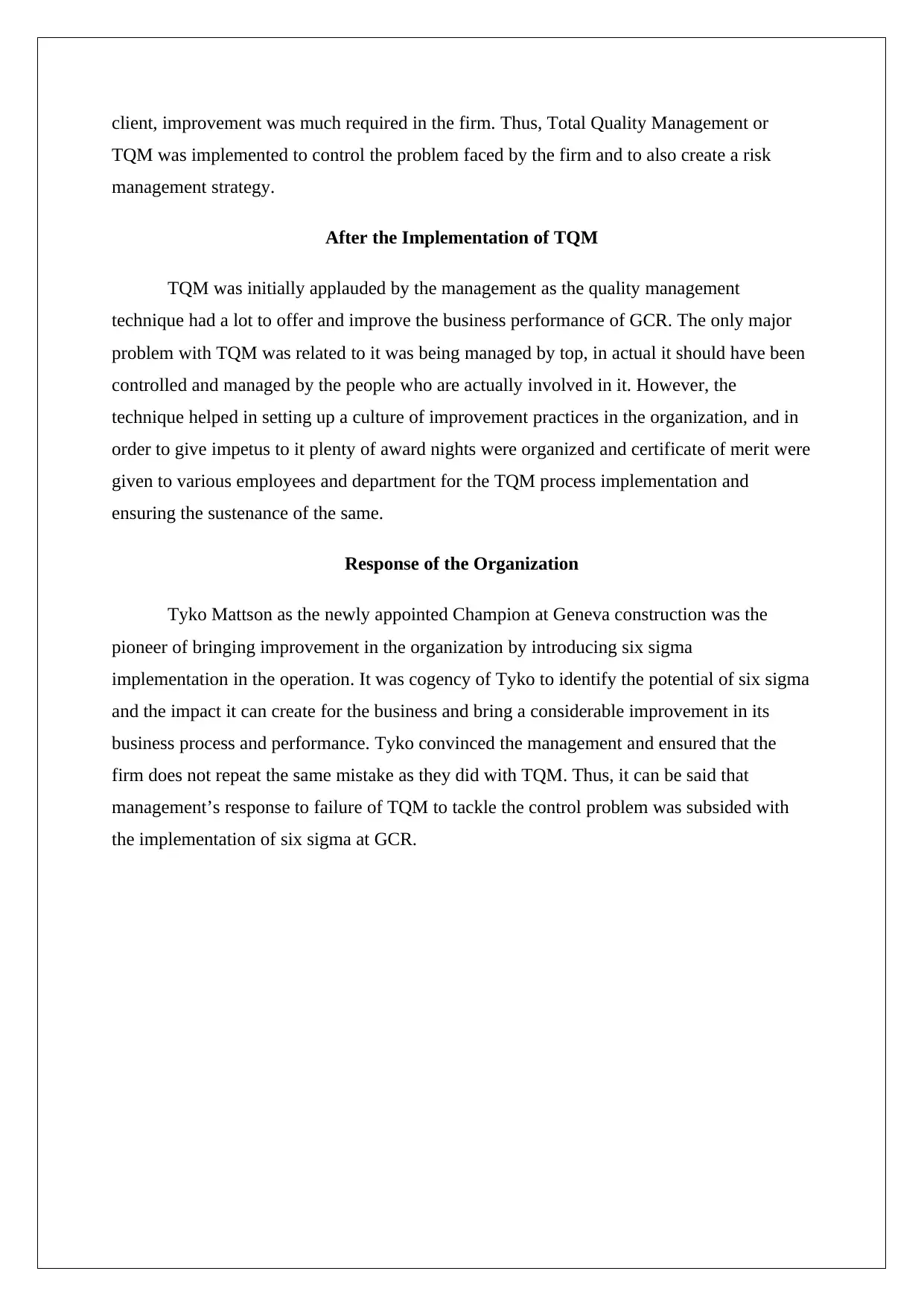
client, improvement was much required in the firm. Thus, Total Quality Management or
TQM was implemented to control the problem faced by the firm and to also create a risk
management strategy.
After the Implementation of TQM
TQM was initially applauded by the management as the quality management
technique had a lot to offer and improve the business performance of GCR. The only major
problem with TQM was related to it was being managed by top, in actual it should have been
controlled and managed by the people who are actually involved in it. However, the
technique helped in setting up a culture of improvement practices in the organization, and in
order to give impetus to it plenty of award nights were organized and certificate of merit were
given to various employees and department for the TQM process implementation and
ensuring the sustenance of the same.
Response of the Organization
Tyko Mattson as the newly appointed Champion at Geneva construction was the
pioneer of bringing improvement in the organization by introducing six sigma
implementation in the operation. It was cogency of Tyko to identify the potential of six sigma
and the impact it can create for the business and bring a considerable improvement in its
business process and performance. Tyko convinced the management and ensured that the
firm does not repeat the same mistake as they did with TQM. Thus, it can be said that
management’s response to failure of TQM to tackle the control problem was subsided with
the implementation of six sigma at GCR.
TQM was implemented to control the problem faced by the firm and to also create a risk
management strategy.
After the Implementation of TQM
TQM was initially applauded by the management as the quality management
technique had a lot to offer and improve the business performance of GCR. The only major
problem with TQM was related to it was being managed by top, in actual it should have been
controlled and managed by the people who are actually involved in it. However, the
technique helped in setting up a culture of improvement practices in the organization, and in
order to give impetus to it plenty of award nights were organized and certificate of merit were
given to various employees and department for the TQM process implementation and
ensuring the sustenance of the same.
Response of the Organization
Tyko Mattson as the newly appointed Champion at Geneva construction was the
pioneer of bringing improvement in the organization by introducing six sigma
implementation in the operation. It was cogency of Tyko to identify the potential of six sigma
and the impact it can create for the business and bring a considerable improvement in its
business process and performance. Tyko convinced the management and ensured that the
firm does not repeat the same mistake as they did with TQM. Thus, it can be said that
management’s response to failure of TQM to tackle the control problem was subsided with
the implementation of six sigma at GCR.
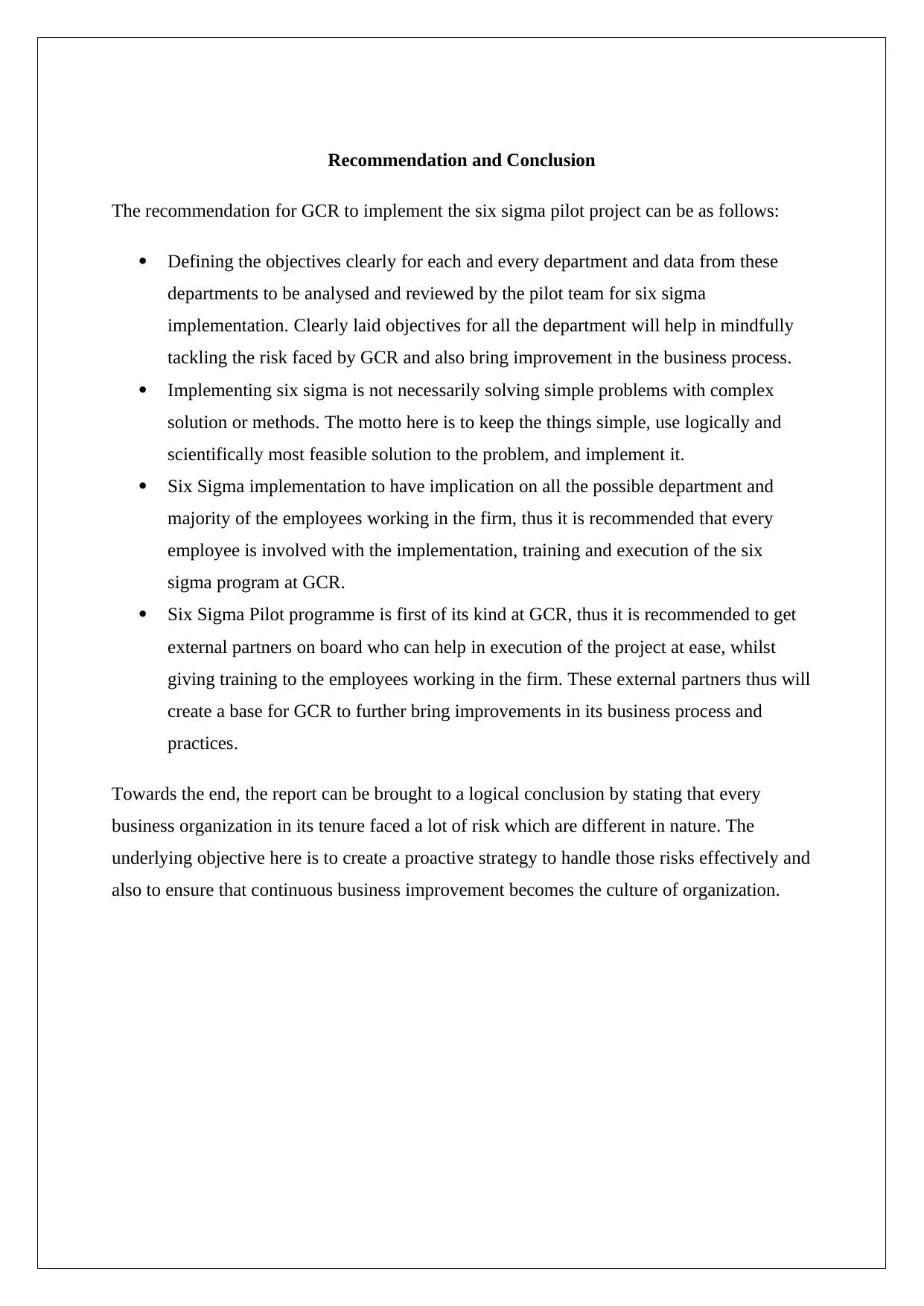
Recommendation and Conclusion
The recommendation for GCR to implement the six sigma pilot project can be as follows:
Defining the objectives clearly for each and every department and data from these
departments to be analysed and reviewed by the pilot team for six sigma
implementation. Clearly laid objectives for all the department will help in mindfully
tackling the risk faced by GCR and also bring improvement in the business process.
Implementing six sigma is not necessarily solving simple problems with complex
solution or methods. The motto here is to keep the things simple, use logically and
scientifically most feasible solution to the problem, and implement it.
Six Sigma implementation to have implication on all the possible department and
majority of the employees working in the firm, thus it is recommended that every
employee is involved with the implementation, training and execution of the six
sigma program at GCR.
Six Sigma Pilot programme is first of its kind at GCR, thus it is recommended to get
external partners on board who can help in execution of the project at ease, whilst
giving training to the employees working in the firm. These external partners thus will
create a base for GCR to further bring improvements in its business process and
practices.
Towards the end, the report can be brought to a logical conclusion by stating that every
business organization in its tenure faced a lot of risk which are different in nature. The
underlying objective here is to create a proactive strategy to handle those risks effectively and
also to ensure that continuous business improvement becomes the culture of organization.
The recommendation for GCR to implement the six sigma pilot project can be as follows:
Defining the objectives clearly for each and every department and data from these
departments to be analysed and reviewed by the pilot team for six sigma
implementation. Clearly laid objectives for all the department will help in mindfully
tackling the risk faced by GCR and also bring improvement in the business process.
Implementing six sigma is not necessarily solving simple problems with complex
solution or methods. The motto here is to keep the things simple, use logically and
scientifically most feasible solution to the problem, and implement it.
Six Sigma implementation to have implication on all the possible department and
majority of the employees working in the firm, thus it is recommended that every
employee is involved with the implementation, training and execution of the six
sigma program at GCR.
Six Sigma Pilot programme is first of its kind at GCR, thus it is recommended to get
external partners on board who can help in execution of the project at ease, whilst
giving training to the employees working in the firm. These external partners thus will
create a base for GCR to further bring improvements in its business process and
practices.
Towards the end, the report can be brought to a logical conclusion by stating that every
business organization in its tenure faced a lot of risk which are different in nature. The
underlying objective here is to create a proactive strategy to handle those risks effectively and
also to ensure that continuous business improvement becomes the culture of organization.
⊘ This is a preview!⊘
Do you want full access?
Subscribe today to unlock all pages.

Trusted by 1+ million students worldwide
1 out of 14
Related Documents
Your All-in-One AI-Powered Toolkit for Academic Success.
+13062052269
info@desklib.com
Available 24*7 on WhatsApp / Email
![[object Object]](/_next/static/media/star-bottom.7253800d.svg)
Unlock your academic potential
Copyright © 2020–2025 A2Z Services. All Rights Reserved. Developed and managed by ZUCOL.




